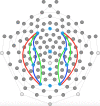The time-locked neurodynamics of semantic processing in autism spectrum disorder: an EEG study
- PMID: 35126770
- PMCID: PMC8807749
- DOI: 10.1007/s11571-021-09697-8
The time-locked neurodynamics of semantic processing in autism spectrum disorder: an EEG study
Abstract
Language processing is often an area of difficulty in Autism Spectrum Disorder (ASD). Semantic processing-the ability to add meaning to a stimulus-is thought to be especially affected in ASD. However, the neurological origin of these deficits, both structurally and temporally, have yet to be discovered. To further previous behavioral findings on language differences in ASD, the present study used an implicit semantic priming paradigm and electroencephalography (EEG) to compare the level of theta coherence throughout semantic processing, between typically developing (TD) and ASD participants. Theta coherence is an indication of synchronous EEG oscillations and was of particular interest due to its previous links with semantic processing. Theta coherence was analyzed in response to semantically related or unrelated pairs of words and pictures across bilateral short, medium, and long electrode connections. We found significant results across a variety of conditions, but most notably, we observed reduced coherence for language stimuli in the ASD group at a left fronto-parietal connection from 100 to 300 ms. This replicates previous findings of underconnectivity in left fronto-parietal language networks in ASD. Critically, the early time window of this underconnectivity, from 100 to 300 ms, suggests that impaired semantic processing of language in ASD may arise during pre-semantic processing, during the initial communication between lower-level linguistic processing and higher-level semantic processing. Our results suggest that language processing functions are unique in ASD compared to TD, and that subjects with ASD might rely on a temporally different language processing loop altogether.
Keywords: Autism spectrum disorder; EEG coherence; Language; Semantic processing.
© The Author(s), under exclusive licence to Springer Nature B.V. 2021.
Conflict of interest statement
Conflict of interestThe authors have no relevant financial or non-financial interests to disclose.
Figures







References
-
- Baggio G. Meaning in the Brain. MIT Press; 2018.
-
- Baribeau D, Anagnostou E. Neuroimaging in autism spectrum disorders. In: Fatemi SH, editor. The molecular basis of autism. Springer; 2015. pp. 117–152.
-
- Baron-Cohen S, Wheelwright S, Skinner R, et al (2001) The Autism-Spectrum Quotient (AQ): Evidence from Asperger Syndrome/High-Functioning Autism, Males and Females, Scientists and Mathematicians. J Autism Dev Disord 31: 5–17 - PubMed
LinkOut - more resources
Full Text Sources

